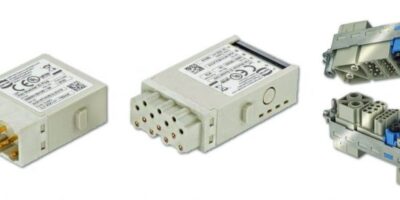Harting’s smart Han-Modular ID connector module prepares for Industry 4.0
Harting has expanded its range of “smart” connectors which can provide identification of key machine components or functional control elements. They are also increasingly being deployed for machinery predictive maintenance. Communication can be via inexpensive bi-directional systems like the I2C bus, as well as standardised bus systems such as controlled area network (CAN) bus.
The CAN ID module is the latest product in the smart Han series. Implementation as a Han-Modular module ensures that identification is flexibly integrated into interfaces which supply machines with power, data and signals, in space-saving conditions.
Transferring identification functionality to the connector shows how such embedded intelligence features can be beneficial to trends for both modular designed processing machinery and machinery with multiple isochronous drives.
For modular designed machinery with pluggable drives, auxiliary equipment and other controller units, ID modules help to ensure that each machine module is instantly recognised by the automation control system as it is fitted or replaced. This saves machine set-up time and limits operator error by ensuring that the correct one is applied according to the operational requirements. Information such as the year of manufacturing, the last revision status and other parameters of the machine unit can also be stored and used for predictive maintenance on the application.
The Han-Modular ID module offers the double functionality of an identification tool and data storage device and paves the way for the customisation of the machine unit.
In addition to local machine control, industrial Wi-Fi modules provide easy connection with the Industry 4.0 manufacturing environment.
Both conventional machinery and special-purpose machinery contain machine components characterised by movement processes made up of individual synchronously executing movements.
Rather than using line shafts, machines with high speeds and accelerated axes are controlled using sensors, drives and motion controllers. The CAN bus operates in real-time and synchronises subscribers. The CAN ID module also enables the current configuration of the drives to be tested and parameters to be transmitted to all other drives and the controller.
The CAN ID module helps implement identification functionality in combination with memory storage capabilities in the device periphery, while also logically complementing existing complex systems, saving time and money on servicing.
For Industry 4.0 applications, integration takes place via network-enabled devices or, in future, directly via an Ethernet interface. This in turn implements end-to-end networking of the data.




